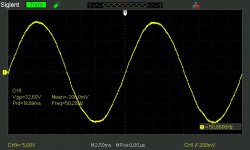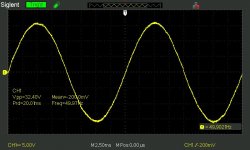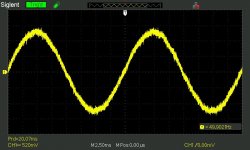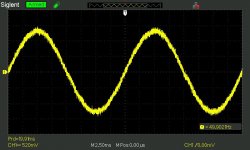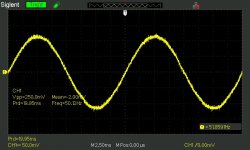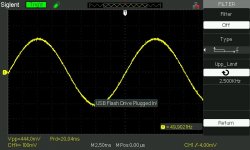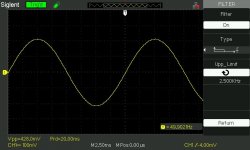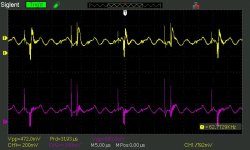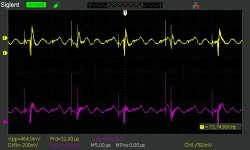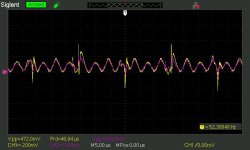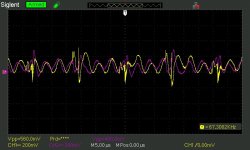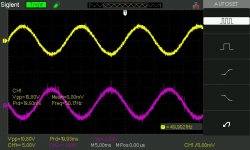Post images (rch, at least) with the timebase set to 2ms, the vertical amplifier set to 5v/div and driving a 50-100Hz signal into the amp. Drive enough signal to fill about 3/4 of the display.
Hopefully this is correct. This scope seems to skip from 1.00ms to 2.50ms, no 2ms option. Pictures are right & left channels
Attachments
Last edited:
There seems to be distortion in both channels on the lower half of the signal.
The 2ms is simply a standard setting. What's generally important is to have about 3 complete cycles on the display. It's OK at 2.5ms. If you wanted to get 3 cycles, you could alter the frequency. No need to do that here.
Do this again at .5v/div. Does the noise become visible there?
The 2ms is simply a standard setting. What's generally important is to have about 3 complete cycles on the display. It's OK at 2.5ms. If you wanted to get 3 cycles, you could alter the frequency. No need to do that here.
Do this again at .5v/div. Does the noise become visible there?
I feel like I have distortion with nothing hooked up to the scope. I don't know what's normal, yet. Should I be grounding the probe to speaker (-) or elsewhere? Here are right, left, and then the scope's own ground & 1khz point. The scope wouldn't lock on at 50hz at exactly .5v/div
Attachments
You can't use the negative speaker terminals on both channels because one channel negative (right channel) has signal. You can use the grounded speaker terminals for critical measurements but having the scope ground connected to the 12v power supply ground is generally all you need.
I don't understand what image 3 is showing.
For reference, post the waveform coming directly from your signal source.
I don't understand what image 3 is showing.
For reference, post the waveform coming directly from your signal source.
What noise are you referring to? The dithering on the top and bottom of the square wave?
The voltage of the source seems adequate but it appears that it may have some distortion. It's hard to tell on this scope. Is there a way to filter the scope (with settings) to get a cleaner signal?
The voltage of the source seems adequate but it appears that it may have some distortion. It's hard to tell on this scope. Is there a way to filter the scope (with settings) to get a cleaner signal?
Yes, that's what I was referring to.
These pictures show the filter option I've found so far. Seems like I need a crash course in oscilloscope usage with amp repair. For this amp I was hoping to diagnose the elevated noise through the right channel with no RCA connection, and ultimately a clean output signal.
These pictures show the filter option I've found so far. Seems like I need a crash course in oscilloscope usage with amp repair. For this amp I was hoping to diagnose the elevated noise through the right channel with no RCA connection, and ultimately a clean output signal.
Attachments
I don't see any noise. Was the noise present while you were monitoring/probing the right channel?
What sort of filter are you using?
Does the noise that you can hear change if you adjust the bias slightly?
What sort of filter are you using?
Does the noise that you can hear change if you adjust the bias slightly?
The first two pictures are the source signal with the filter on, third picture is with filter off. It was set to 2.5khz low pass. I'll check the gain adjustment tomorrow.
*bias adjustment.
No change with bias adjustment, except that now I don't seem to have any more noise out of the right channel vs the left. Not sure if that happened before or after playing with the bias, but also there doesn't seem to be any significant change between RCA plugged in or not. At this point it's barely audible with my ear right up to the speaker.
This is what right & left channels look like with and without RCAs hooked up for the first two pictures, third picture is centered without RCA.
No change with bias adjustment, except that now I don't seem to have any more noise out of the right channel vs the left. Not sure if that happened before or after playing with the bias, but also there doesn't seem to be any significant change between RCA plugged in or not. At this point it's barely audible with my ear right up to the speaker.
This is what right & left channels look like with and without RCAs hooked up for the first two pictures, third picture is centered without RCA.
Attachments
While you have this amp, you should try temporarily setting both the gain and treble at max to see if it will oscillate (have all transistors clamped tightly to the heatsink).
If it does, you will know what to look for in the future and you will be able to tell the owner of this problem.
If it does, you will know what to look for in the future and you will be able to tell the owner of this problem.
What problem would that be indicative of? I did notice a slight increase in the noise when turning the bass pot up, and when turning the gain to maximum, but I didn't look at the output with the scope at that point.
It's a design flaw. It could likely be resolved by changing the value of or adding a capacitor to the right point in the circuit but as far as I know, no one ever bothered doing it.
The oscillation is generally ultrasonic so you probably have to look at the output of the amp to know it's happening.
The oscillation is generally ultrasonic so you probably have to look at the output of the amp to know it's happening.
That's not oscillating. If it was oscillating, the waveform would be swinging rail-rail, most likely. It would look similar to what you'd see on the outputs of a class D amp.
Try it with a speaker connected and a signal (at a low level). It if doesn't oscillate, it may be one that was produced after they saw that there was a problem.
Watch the output of the amp continuously and be ready to shut it down until you know 100% that it's OK. Be aware that the amp, when oscillating, can destroy tweeters within seconds.
Try it with a speaker connected and a signal (at a low level). It if doesn't oscillate, it may be one that was produced after they saw that there was a problem.
Watch the output of the amp continuously and be ready to shut it down until you know 100% that it's OK. Be aware that the amp, when oscillating, can destroy tweeters within seconds.
When testing for instability (tendency to oscillate), music with high frequency content is more likely to trigger the oscillation.
I ran it up pretty high on music with gain & treble both at max, but without speakers attached. Never saw any oscillation on the scope, but I was getting music emanating from the amp board. I couldn't pinpoint where it was coming from - it seemed to be louder on the right channel than left when alternating running them at full gain.
- Home
- General Interest
- Car Audio
- Rockford Fosgate 225.2
